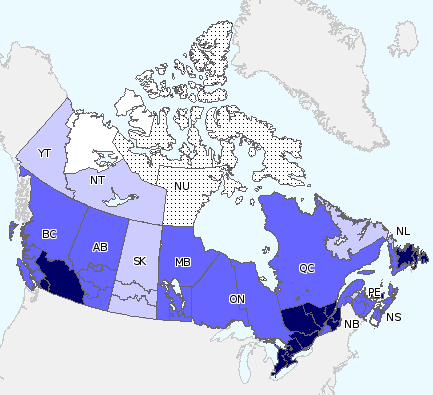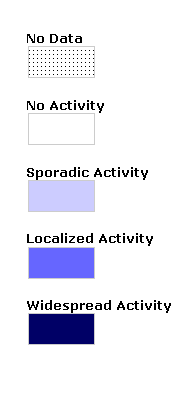FluWatch report: January 18 to January 24, 2015 (Week 3)
Overall summary
- In week 3, all influenza indicators declined from the previous week, indicating that peak of the influenza season in Canada may have passed.
- A(H3N2) continues to be the most common type of influenza affecting Canadians. In both laboratory detections, hospitalizations and deaths, the majority of cases have been among seniors ≥65 years of age.
- On January 26, 2015, the first imported human case of avian influenza A (H7N9) from China was confirmed in Canada. A second case was confirmed on January 29, 2015. They are the first North Americans known to have been infected with this virus. The individuals were from British Columbia and travelled together to China. Neither required hospitalization and both have recovered. Close contacts are being monitored by appropriate public health authorities. The risk of Canadians getting sick with avian influenza A (H7N9) is very low.
- A Canadian study has examined the mid-season data on the current flu vaccine's effectiveness in Canada. The study observed little to no vaccine protection against the A(H3N2) virus, this season’s most common influenza virus. The results of this study are not unexpected. As flu viruses move through the population, they can change or drift. The time it takes from the start to the finish of a vaccine production, is sometimes sufficient time for the virus to change, which is what happened this year in particular with H3N2. Evidence from the NML, however, still suggests that the vaccine continues to provide protection against the circulating A(H1N1) and B strains.
Are you a primary health care practitioner (General Practitioner, Nurse Practitioner or Registered Nurse) interested in becoming a FluWatch sentinel for the 2014-15 influenza season? Contact us at FluWatch@phac-aspc.gc.ca
On this page
- Influenza/ILI Activity (geographic spread)
- Influenza and Other Respiratory Virus Detections
- Antiviral Resistance
- Influenza Strain Characterizations
- Influenza-like Illness (ILI) Consultation Rate
- Influenza Outbreak Surveillance
- Pharmacy surveillance
- Sentinel Hospital Influenza Surveillance
- Provincial/Territorial Influenza Hospitalizations and Deaths
- Emerging Respiratory Pathogens
- International Influenza Reports

Download the alternative format
(PDF format, 804 KB, 10 pages)
Organization: Public Health Agency of Canada
Date published: 2015-01-30
Related Topics
Influenza/ILI Activity (geographic spread)
In week 03, 15 regions reported widespread activity: in BC(2), ON(5), QC(4), NF(3) and PEI. Twenty-five regions reported localized activity: in BC(3), AB(5), MB(5), ON(2), QC(2), NB(6), NS(6) and NL and seven regions reported sporadic activity: in NWT, YK, SK(3), NB and NF. NU did not report data for week 03.
Figure 1. Map of overall influenza/ILI activity level by province and territory, Canada, Week 03
Note: Influenza/ILI activity levels, as represented on this map, are assigned and reported by Provincial and Territorial Ministries of Health, based on laboratory confirmations, sentinel ILI rates and reported outbreaks. Please refer to detailed definitions at the end of the report. Maps from previous weeks, including any retrospective updates, are available on the Flu Activity website.
Figure 1 - Text Description
In week 03, 15 regions reported widespread activity: in BC(2), ON(5), QC(4), NF(3) and PEI. Twenty-five regions reported localized activity: in BC(3), AB(5), MB(5), ON(2), QC(2), NB(6), NS(6) and NL and seven regions reported sporadic activity: in NWT, YK, SK(3), NB and NF. NU did not report data for week 03.
Influenza and Other Respiratory Virus Detections
The number of positive tests decreased from 3,829 in week 02 to 2,928 in week 03. The percentage of positive influenza tests also decreased slightly from 28.3% to 27.4% (Figure 2). To date, 97% of influenza detections have been influenza A, and 99.8% of those subtyped have been A(H3N2) (Table 1).To date this season, detailed information on age and type/subtype has been received for 24,071 cases. A significantly greater proportion of laboratory detections of influenza have been reported in adults ≥65 years of age (63%) this season compared to the 2013-14 season when only 15.4% of cases were in adults ≥65 years of age (Table 2).
Figure 2. Number of positive influenza tests and percentage of tests positive, by type, subtype and report week, Canada, 2014-15

Figure 2 - Text Description
The number of positive tests decreased from 3,829 in week 02 to 2,928 in week 03. The percentage of positive influenza tests also decreased slightly from 28.3% to 27.4%.
In week 03, the number of positive respiratory syncytial virus (RSV) tests decreased to 894 RSV detections and remains the second most frequently detected virus after influenza. Detections of RSV since week 38 have been higher than in the previous season. Detections of other respiratory viruses have been declining and have generally been lower this season compared to the previous season (figure 3).
For more details, see the weekly Respiratory Virus Detections in Canada Report.
Figure 3. Number of positive laboratory tests for other respiratory viruses by report week, Canada, 2014-15
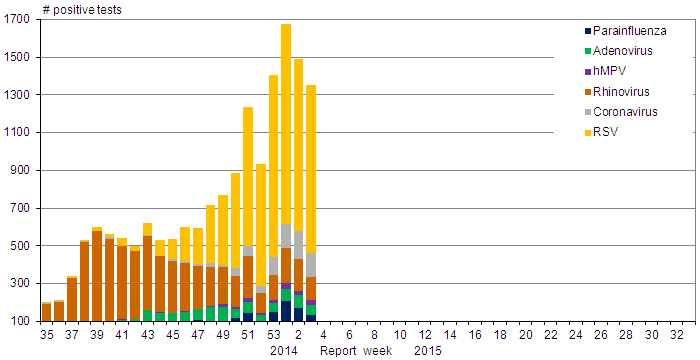 RSV: Respiratory syncytial virus; hMPV: Human metapneumovirus
RSV: Respiratory syncytial virus; hMPV: Human metapneumovirus
Figure 3 - Text Description
In week 03, the number of positive respiratory syncytial virus (RSV) tests decreased to 894 RSV detections and remains the second most frequently detected virus after influenza. Detections of RSV since week 38 have been higher than in the previous season. Detections of other respiratory viruses have been declining and have generally been lower this season compared to the previous season.
| Reporting provincesFootnote 1 | Weekly (January 18 to January 24, 2015) | Cumulative (August 24, 2014 to January 24, 2015) | ||||||||
|---|---|---|---|---|---|---|---|---|---|---|
| Influenza A | B | Influenza A | B | |||||||
| A Total | A(H1)pdm09 | A(H3) | A Footnote (Uns) | B Total | A Total | A(H1)pdm09 | A(H3) | A(UnS) | B Total | |
| BC | 514 | 3 | 369 | 142 | 12 | 2386 | 5 | 1815 | 566 | 58 |
| AB | 124 | 1 | 94 | 29 | 32 | 3340 | 2 | 3194 | 144 | 224 |
| SK | 41 | 0 | 0 | 41 | 0 | 1028 | 0 | 0 | 1028 | 9 |
| MB | 129 | 2 | 609 | 481 | 7 | 6814 | 8 | 3067 | 3739 | 82 |
| ON | 1092 | 2 | 609 | 481 | 7 | 6814 | 8 | 3067 | 3739 | 82 |
| QC | 617 | 0 | 0 | 617 | 53 | 9243 | 3 | 422 | 8818 | 370 |
| NB | 145 | 0 | 20 | 125 | 5 | 277 | 0 | 25 | 252 | 8 |
| NS | 52 | 0 | 36 | 16 | 0 | 187 | 0 | 91 | 96 | 13 |
| PE | 10 | 0 | 10 | 0 | 0 | 47 | 1 | 44 | 2 | 1 |
| NL | 64 | 0 | 0 | 64 | 1 | 458 | 0 | 53 | 405 | 3 |
| Canada | 2788 | 6 | 1163 | 1619 | 112 | 24737 | 19 | 9062 | 15656 | 787 |
| Percentage Footnote 2 | 96.1% | 0.2% | 41.7% | 58.1% | 3.9% | 96.9% | 0.1% | 36.6% | 63.3% | 3.1% |
| Age groups (years) | Weekly January 18 to January 24, 2015 | Cumulative (August 24, 2014 to January 24, 2015) | ||||||||||
|---|---|---|---|---|---|---|---|---|---|---|---|---|
| Influenza A | B | Influenza A | B | Influenza A and B | ||||||||
| A Total | A(H1) pdm09 | A(H3) | A Footnote (Uns) | Total | A Total | A(H1) pdm09 | A(H3) | A (UnS) | Total | # | % | |
| <5 | 104 | 0 | 26 | 78 | 4 | 1560 | 5 | 634 | 921 | 71 | 1631 | 6.8% |
| 5-19 | 85 | 0 | 25 | 60 | 12 | 1379 | 0 | 756 | 623 | 92 | 1471 | 6.1% |
| 20-44 | 162 | 2 | 60 | 100 | 12 | 2652 | 4 | 1187 | 1461 | 117 | 2769 | 11.5% |
| 45-64 | 225 | 1 | 93 | 131 | 34 | 2891 | 4 | 1121 | 1766 | 179 | 3070 | 12.8% |
| 65+ | 1155 | 0 | 497 | 658 | 35 | 14763 | 5 | 5367 | 9391 | 302 | 15065 | 62.6% |
| Unknown | 18 | 0 | 16 | 2 | 0 | 63 | 0 | 49 | 14 | 2 | 65 | 0.3% |
| Total | 1749 | 3 | 717 | 1029 | 97 | 23308 | 18 | 9114 | 14176 | 763 | 24071 | 100.0% |
| PercentageFootnote 2, | 94.7% | 0.2% | 41.9% | 58.8% | 5.3% | 96.8% | 0.1% | 39.1% | 60.8% | 3.2% | ||
Antiviral Resistance
During the 2014-2015 influenza season, the NML has tested 317 influenza viruses for resistance to oseltamivir and 313 influenza viruses for resistance to zanamivir and all were sensitive to both agents. A total of 605 (99.8%) of influenza A viruses were resistant to amantadine (Table 3).
| Virus type and subtype | Oseltamivir | Zanamivir | Amantadine | |||
|---|---|---|---|---|---|---|
| # tested | # resistant (%) | # tested | # resistant (%) | # tested | # resistant (%) | |
| A (H3N2) | 274 | 0 | 270 | 0 | 604 | 603 (99.8%) |
| A (H1N1) | 2 | 0 | 2 | 0 | 2 | 2 (100%) |
| B | 41 | 0 | 41 | 0 | NATable 3 - Footnote * | NA Table 3 - Footnote * |
| TOTAL | 317 | 0 | 313 | 0 | 606 | 605 |
Influenza Strain Characterizations
During the 2014-2015 influenza season, the National Microbiology Laboratory (NML) has characterized 132 influenza viruses [68 A(H3N2), 2 A(H1N1) and 62 influenza B]. The majority of circulating influenza B and A(H1N1) viruses have been antigenically similar (good match) to the recommended strains for the 2014-15 seasonal influenza vaccine, while the majority of A(H3N2) viruses have shown evidence of an antigenic drift (sub-optimal match) from the vaccine strain.
Influenza A (H3N2): When tested by hemagglutination inhibition (HI) assay (n=68), one virus was antigenically similar to A/Texas/50/2012, five showed reduced titers to A/Texas/50/2012 and 62 were antigenically similar to A/Switzerland/9715293/2013, which is the influenza A(H3N2) component recommended for the 2015 Southern Hemisphere influenza vaccine. Additionally, 474 A(H3N2) viruses were unable to be tested by HI assay; however, sequence analysis showed that 472 belonged to a genetic group that typically shows reduced titers to A/Texas/50/2012.
Influenza A(H1N1): Two A(H1N1) viruses characterized were antigenically similar to A/California/7/2009.
Influenza B: Of the 62 influenza B viruses characterized, 56 viruses were antigenically similar to B/Massachusetts/2/2012, three viruses showed reduced titers against B/Massachusetts/2/2012, and three were B/Brisbane/60/2008-like (Figure 4).
Figure 4. Influenza strain characterizations, Canada, 2014-2015, N = 132

The NML receives a proportion of the number of influenza positive specimens from provincial laboratories for strain characterization and antiviral resistance testing. Characterization data reflect the results of haemagglutination inhibition (HAI) testing compared to the reference influenza strains recommended by WHO.
The recommended components for the 2014-2015 northern hemisphere trivalent influenza vaccine include: an A/California/7/2009(H1N1)pdm09-like virus, an A/Texas/50/2012 (H3N2)-like virus, and a B/Massachusetts/2/2012 -like virus (Yamagata lineage). For quadrivalent vaccines, the addition of a B/Brisbane/60/2008-like virus is recommended.
Figure 4 - Text Description
| Strain | Number of specimens | Percentage |
|---|---|---|
| A/Texas/50/2012-like | 1 | 1% |
| reduced titres to A/Texas/50/2012 | 5 | 4% |
| A/California/07/2009-like | 2 | 2% |
| A/Switzerland/97 15293/2013-like | 62 | 47% |
| B/Massachusetts/2/2012-like | 56 | 42% |
| reduced titres to B/Massachusetts/2/2012 | 3 | 2% |
| B/Brisbane/60/2008-like | 3 | 2% |
Influenza-like Illness (ILI) Consultation Rate
The national influenza-like-illness (ILI) consultation increased in week 03 to 45.3 consultations per 1,000, which is slightly above expected levels (Figure 5).
Figure 5. Influenza-like-illness (ILI) consultation rates by report week, compared to the 1996-97 through to 2012-13 seasons (with pandemic data suppressed), Canada, 2014-2015
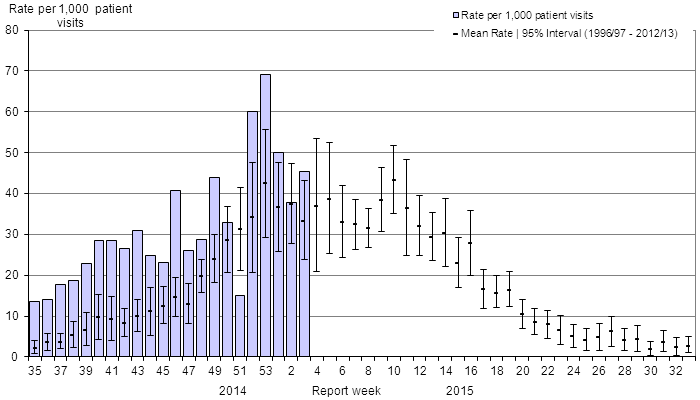
No data available for mean rate for weeks 19 to 39 for the 1996-1997 through 2002-2003 seasons. Delays in the reporting of data may cause data to change retrospectively. The calculation of the average ILI consultation rate over 17 seasons was aligned with influenza activity in each season. In BC, AB, and SK, data is compiled by a provincial sentinel surveillance program for reporting to FluWatch. Not all sentinel physicians report every week.
Figure 5 - Text Description
The national influenza-like-illness (ILI) consultation increased in week 03 to 45.3 consultations per 1,000, which is slightly above expected levels.
Influenza Outbreak Surveillance
In week 03, 72 new outbreaks of influenza were reported, nearly half the number of outbreaks reported in the previous week. Fifty-four outbreaks were reported in long-term care facilities (LTCF), six in hospitals and 12 in institutional or community settings (Figure 6). Among the outbreaks in which the influenza subtype was known, seven LTCF outbreaks and one institutional or community setting outbreak were associated with A(H3N2), and four LTCF outbreaks associated with influenza B. To date this season, 795 outbreaks in LTCFs have been reported and the majority of those with known subtypes were attributable to A(H3N2). There has been a higher number of reported influenza outbreaks to date this season compared to the same period in previous seasons.
Figure 6: Overall number of new laboratory-confirmed influenza outbreaks by report week, Canada, 2014-2015
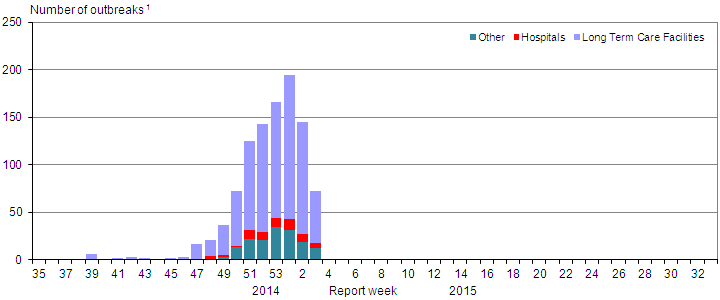
1 All provinces and territories except NU report outbreaks in long-term care facilities. All provinces and territories with the exception of NU and QC report outbreaks in hospitals. Outbreaks of influenza or influenza-like-illness in other facilities are reported to FluWatch but reporting varies between jurisdictions. Outbreak definitions are included at the end of the report.
Figure 6 - Text Description
| Report week | Hospitals | Long Term Care Facilities | Other |
|---|---|---|---|
| 35 | 0 | 0 | 0 |
| 36 | 0 | 0 | 0 |
| 37 | 0 | 0 | 0 |
| 38 | 0 | 1 | 0 |
| 39 | 0 | 5 | 1 |
| 40 | 0 | 0 | 0 |
| 41 | 0 | 2 | 0 |
| 42 | 0 | 3 | 0 |
| 43 | 0 | 2 | 0 |
| 44 | 0 | 1 | 0 |
| 45 | 0 | 2 | 0 |
| 46 | 0 | 3 | 0 |
| 47 | 0 | 16 | 1 |
| 48 | 3 | 17 | 1 |
| 49 | 2 | 32 | 3 |
| 50 | 2 | 57 | 13 |
| 51 | 9 | 94 | 22 |
| 52 | 8 | 114 | 21 |
| 53 | 9 | 122 | 35 |
| 1 | 12 | 152 | 31 |
| 2 | 8 | 118 | 19 |
| 3 | 6 | 54 | 14 |
Pharmacy surveillance
During week 03, the proportion of prescriptions for antivirals decreased to 511.3 antiviral prescriptions per 100,000 total prescriptions (down from 806.1 per 100,000). The rate for antivirals since week 48 has been higher than the previous three seasons (Figure 7). The rate in age groups except in infants decreased in week 03. The antiviral prescription rate remains the highest amongst seniors at 859.9 per 100,000 total prescriptions.
Figure 7. Proportion of prescription sales for influenza antivirals by age-group and week, Canada, 2014-15
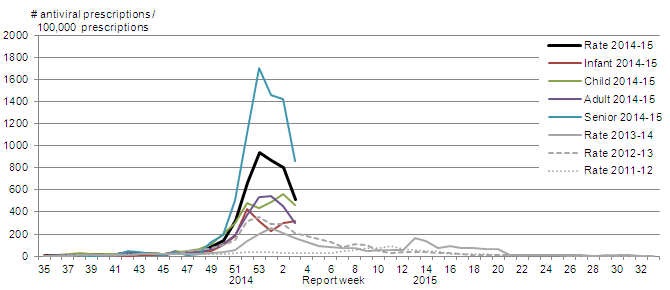
Note: Pharmacy sales data are provided to the Public Health Agency of Canada by Rx Canada Inc. and sourced from major retail drug chains representing over 2,500 stores nationwide (excluding Nunavut) in 85% of Health Regions. Data provided include the number of new antiviral prescriptions (for Tamiflu and Relenza) and the total number of new prescriptions dispensed by Province/Territory and age group. Age-groups: Infant: 0-2y, Child: 2-18y; Adult: 19-64y; Senior: ≥65y
Figure 7 - Text Description
Proportion of antiviral prescriptions per 100,000 total prescriptions in week 03 for the current season compared to previous seasons:
2014-15: 511.3; 2013-14: 165.7; 2012-13: 212.8; 2011-12: 25.4
Proportion of antiviral prescriptions by age-group in week 03 for the 2014-15 season:
Infant: 320.6; child: 460.7; adult: 298.1; senior: 859.9
Sentinel Hospital Influenza Surveillance
Paediatric Influenza Hospitalizations and Deaths (IMPACT)
In week 03, 29 laboratory-confirmed influenza-associated paediatric (≤16 years of age) hospitalizations were reported by the Immunization Monitoring Program Active (IMPACT) network: 28 cases of influenza A and one case of influenza B (Figure 8a). Among the reported cases, 12 (41%) were <2 years of age, 15 (52%) were 2 to 9 years of age and two (7%) were 10-16 years of age. Three cases were admitted to the ICU. To date this season, 446 hospitalizations have been reported by the IMPACT network, 421 (94%) of which were cases of influenza A. Among cases for which the influenza A subtype was reported, 99% (137/139) were A(H3N2) (Table 4). To date, 50 cases were admitted to the ICU, of which 32 (64%) were 2 to 9 years of age (Figure 9a). Two deaths have been reported.
Note: The number of hospitalizations reported through IMPACT represents a subset of all influenza-associated paediatric hospitalizations in Canada. Delays in the reporting of data may cause data to change retrospectively.
Adult Influenza Hospitalizations and Deaths (PCIRN)
In week 03, 98 laboratory-confirmed influenza-associated adult (≥16 years of age) hospitalizations were reported by the PHAC/CIHR Influenza Research Network (PCIRN) Serious Outcomes Surveillance (SOS) network. Among cases in week 03, 81 cases (83%) were in adults over the age of 65 and 94 cases (96%) had influenza A (Figure 8b). To date this season, 1259 cases have been reported; 1244 (99%) with influenza A. The majority of cases (84%) were among adults ≥65 years of age (Table 5). Eighty-eight ICU admissions have been reported and the majority of cases (80%) were adults ≥65 years of age, most (83%) with known underlying conditions or comorbidities. Fifty-four deaths have been reported, all but three were adults >65 years of age (Figure 9B).
Note: The number of hospitalizations reported through PCIRN represents a subset of all influenza-associated adult hospitalizations in Canada. Delays in the reporting of data may cause data to change retrospectively.
| Age groups | Cumulative (Aug. 24, 2014 to January 24, 2015) | |||||
|---|---|---|---|---|---|---|
| Influenza A | B | Influenza A and B | ||||
| A Total | A(H1) pdm09 | A(H3) | AFootnote (Uns) | Total | # (%) | |
| 0-5m | 68 | 0 | 13 | 55 | 2 | 70 (15.7%) |
| 6-23m | 92 | 1 | 28 | 63 | 10 | 102 (22.9%) |
| 2-4y | 101 | 1 | 35 | 65 | 4 | 105 (23.5%) |
| 5-9y | 105 | 0 | 38 | 67 | 6 | 111 (24.9%) |
| 10-16y | 55 | 0 | 23 | 32 | 3 | 58 (13.0%) |
| Total | 421 | 2 | 137 | 282 | 25 | 446 |
| % Footnote 1 | 94.4% | 0.5% | 32.5% | 67.0% | 5.6% | 100.0% |
| Age groups | Cumulative (November 15, 2014 to January 24, 2015) | |||||
|---|---|---|---|---|---|---|
| Influenza A | B | Influenza A and B | ||||
| A Total | A(H1) pdm09 | A(H3) | AFootnote (Uns) | Total | # (%) | |
| 16-20 | 3 | 0 | 0 | 3 | 0 | 3 (%) |
| 20-44 | 71 | 0 | 22 | 49 | 1 | 72 (6%) |
| 45-64 | 129 | 0 | 47 | 82 | 2 | 131 (10%) |
| 65+ | 1041 | 2 | 318 | 721 | 12 | 1053 (84%) |
| Total | 1244 | 2 | 387 | 855 | 15 | 1259 |
| % Footnote 1 | 99% | 0% | 31% | 69% | 1% | 100% |
Figure 8 - Number of cases of influenza reported by sentinel hospital networks, by week, Canada, 2014-15
8A) Paediatric hospitalizations (≤16 years of age, IMPACT)

Figure 8A - Text Description
| Report week | Influenza A | Influenza B |
|---|---|---|
| 35 | 0 | 0 |
| 36 | 0 | 0 |
| 37 | 2 | 0 |
| 38 | 1 | 0 |
| 39 | 1 | 0 |
| 40 | 1 | 0 |
| 41 | 2 | 0 |
| 42 | 1 | 0 |
| 43 | 3 | 1 |
| 44 | 4 | 0 |
| 45 | 4 | 0 |
| 46 | 9 | 3 |
| 47 | 8 | 1 |
| 48 | 15 | 4 |
| 49 | 30 | 2 |
| 50 | 43 | 2 |
| 51 | 54 | 1 |
| 52 | 65 | 2 |
| 53 | 50 | 1 |
| 1 | 53 | 5 |
| 2 | 42 | 2 |
| 3 | 28 | 1 |
8B) Adult hospitalizations (≥16 year of age, PCIRN-SOS)
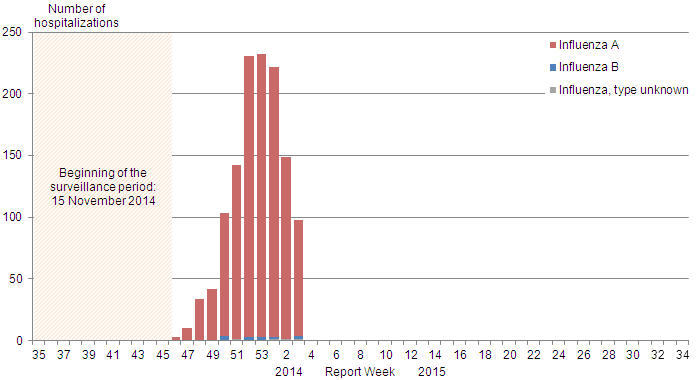
Note: Data for week 46 is based on data collected for 1 day only and do not represent the number of hospitalizations for the entire week.
Figure 8B - Text Description
| Report week | Influenza A | Influenza B | Untyped |
|---|---|---|---|
| 35 | n/a | n/a | n/a |
| 36 | n/a | n/a | n/a |
| 37 | n/a | n/a | n/a |
| 38 | n/a | n/a | n/a |
| 39 | n/a | n/a | n/a |
| 40 | n/a | n/a | n/a |
| 41 | n/a | n/a | n/a |
| 42 | n/a | n/a | n/a |
| 43 | n/a | n/a | n/a |
| 44 | n/a | n/a | n/a |
| 45 | n/a | n/a | n/a |
| 46 | 3 | 0 | 0 |
| 47 | 10 | 0 | 0 |
| 48 | 34 | 0 | 0 |
| 49 | 42 | 0 | 0 |
| 50 | 99 | 4 | 0 |
| 51 | 141 | 0 | 1 |
| 52 | 228 | 3 | 0 |
| 53 | 229 | 3 | 0 |
| 1 | 219 | 2 | 1 |
| 2 | 148 | 0 | 1 |
| 3 | 94 | 3 | 1 |
Figure 9 - Percentage of hospitalizations, ICU admissions and deaths with influenza reported by age-group, Canada, 2014-15
9A) Paediatric hospitalizations (≤16 years of age, IMPACT)

Figure 9A - Text Description
| Age-group (years) | Hospitalizations(n=446) | ICU admissions(n=50) |
|---|---|---|
| 0-5m | 15.7% | 0.0% |
| 6-23m | 22.9% | 16.0% |
| 2-4y | 23.5% | 38.0% |
| 5-9y | 24.9% | 26.0% |
| 10-16y | 13.0% | 20.0% |
9B) Adult hospitalizations (≥16 year of age, PCIRN-SOS)

Figure 9B - Text Description
| Age-group (years) | Hospitalizations (n=1255) | ICU admissions(n=88) | Deaths (n=54) |
|---|---|---|---|
| 16-20 | 0.2% | 0.0% | 0.0% |
| 20-44 | 5.7% | 5.7% | 0.0% |
| 45-64 | 10.4% | 14.8% | 5.6% |
| 65+ | 83.6% | 79.5% | 94.4% |
Provincial/Territorial Influenza Hospitalizations and Deaths
In week 03, 357 laboratory-confirmed influenza-associated hospitalizations were reported from participating provinces and territoriesFootnote * ; all but one with influenza A, and 74% were patients ≥65 years of age. Since the start of the 2014-15 season, 3,589 hospitalizations have been reported; 3,523 (98%) with influenza A. Among cases for which the subtype of influenza A was reported, 99.7% (1720/1725) were A(H3N2). The majority of cases (71%) were ≥65 years of age (Table 6). A total of 104 ICU admissions have been reported in adults ≥65 years of age with influenza A and 52 ICU admissions have been reported in adults 20-64 years. A total of 236 deaths have been reported since the start of the season: one child <5 years of age, two children 5-19 years, sixteen adults 20-64 years, and 217 adults ≥65 years of age. Adults 65 years of age or older represent 92% of all deaths reported this season. Detailed clinical information (e.g. underlying medical conditions) is not known for these cases.
| Age groups | Cumulative (24 August 2014 to 24 January 2015) | |||||
|---|---|---|---|---|---|---|
| Influenza A | B | Influenza A and B | ||||
| A Total | A(H1) pdm09 | A(H3) | AFootnote (Uns) | Total | # (%) | |
| 0-4 years | 258 | 2 | 103 | 153 | 3 | 261 (7%) |
| 5-19 years | 171 | 0 | 95 | 76 | 5 | 176 (5%) |
| 20-44 years | 186 | 1 | 104 | 81 | 6 | 192 (5%) |
| 45-64 years | 366 | 2 | 182 | 182 | 8 | 374 (10%) |
| 65+ years | 2493 | 0 | 1189 | 1304 | 40 | 2533 (71%) |
| Unknown | 49 | 0 | 47 | 2 | 4 | 53 (1%) |
| Total | 3523 | 5 | 1720 | 1798 | 66 | 3589 |
| Percentage Footnote 1 | 98.2% | 0.1% | 48.8% | 51.0% | 1.8% | 100.0% |
See additional data on Reported Influenza Hospitalizations and Deaths in Canada: 2009-10 to 2014-15 on the Public Health Agency of Canada website.
Emerging Respiratory Pathogens
Human Avian Influenza
Influenza A(H7N9): On January 26, 2015, the first imported human case of avian influenza A (H7N9) from China was confirmed in Canada. A second case was confirmed on January 29, 2015. They traveled together to China and recently returned to Canada. All evidence regarding the Canadian cases indicates they were likely infected following exposure in China. They were not symptomatic during travel and only became ill after arrival in Canada. These are the first documented cases of H7N9 infection in humans in North America. The risk to Canadians of getting sick with H7N9 remains very low as evidence suggests that it does not transmit easily from person-to-person.
Since the last FluWatch report, one new laboratory-confirmed case of human infection with avian influenza A(H7N9) virus was reported by the World Health Organization (not including the Canadian cases). The case was a 79 year-old male with a history of exposure to live poultry. The case has been in stable condition all along. Globally to January 30, 2015, the WHO reported a total of 486 laboratory-confirmed human cases with avian influenza A(H7N9) virus, including 185 deaths.
Documents related to the public health risk of influenza A(H7N9), as well as guidance for health professionals and advice for the public is updated regularly on the following websites:
Influenza A(H5N6): Since the last FluWatch report, no new cases of human infection with avian influenza A (H5N6) virus from China has been reported by the World Health Organization. Globally to January 16, 2015, the WHO has been informed of a total of two cases of avian influenza A (H5N6) virus, including one death.
Middle East Respiratory Syndrome Coronavirus (MERS-CoV)
Since the last FluWatch report, 6 new laboratory-confirmed cases of MERS-CoV have been reported by the World Health Organization from Saudi Arabia (5) and Oman (1). Globally, from September 2012 to January 30, 2015, the WHO has been informed of a total of 956 laboratory-confirmed cases of infection with MERS-CoV, including 351 deaths. All cases have either occurred in the Middle East or have had direct links to a primary case infected in the Middle East. The public health risk posed by MERS-CoV in Canada remains low (see the PHAC Assessment of Public Health Risk).
Documents related to the public health risk of MERS-CoV, as well as guidance for health professionals and advice for the public is updated regularly on the following websites:
Avian Influenza A(H5)
The Canadian Food Inspection Agency (CFIA) is continuing its investigation into an outbreak of highly pathogenic avian influenza H5N2 virus in British Columbia's Fraser Valley. No new sites have been identified since December 19, 2014. Further information on the outbreak is provided on the following CFIA website.
Enterovirus D68 (EV-D68)
Information related to enterovirus D68, as well as guidance for health professionals and advice for the public is updated regularly:
International Influenza Reports
- World Health Organization influenza update
- World Health Organization FluNet
- WHO Influenza at the human-animal interface
- Centers for Disease Control and Prevention seasonal influenza report
- European Centre for Disease Prevention and Control - epidemiological data
- South Africa Influenza surveillance report
- New Zealand Public Health Surveillance
- Australia Influenza Report
- Pan-American Health Organization Influenza Situation Report
FluWatch definitions for the 2014-2015 season
Abbreviations: Newfoundland/Labrador (NL), Prince Edward Island (PE), New Brunswick (NB), Nova Scotia (NS), Quebec (QC), Ontario (ON), Manitoba (MB), Saskatchewan (SK), Alberta (AB), British Columbia (BC), Yukon (YT), Northwest Territories (NT), Nunavut (NU).
Influenza-like-illness (ILI): Acute onset of respiratory illness with fever and cough and with one or more of the following - sore throat, arthralgia, myalgia, or prostration which is likely due to influenza. In children under 5, gastrointestinal symptoms may also be present. In patients under 5 or 65 and older, fever may not be prominent.
ILI/Influenza outbreaks
- Schools:
-
Greater than 10% absenteeism (or absenteeism that is higher (e.g. >5-10%) than expected level as determined by school or public health authority) which is likely due to ILI.
Note: it is recommended that ILI school outbreaks be laboratory confirmed at the beginning of influenza season as it may be the first indication of community transmission in an area. - Hospitals and residential institutions:
- two or more cases of ILI within a seven-day period, including at least one laboratory confirmed case. Institutional outbreaks should be reported within 24 hours of identification. Residential institutions include but not limited to long-term care facilities ( LTCF) and prisons.
- Workplace:
- Greater than 10% absenteeism on any day which is most likely due to ILI.
- Other settings:
- two or more cases of ILI within a seven-day period, including at least one laboratory confirmed case; i.e. closed communities.
Note that reporting of outbreaks of influenza/ILI from different types of facilities differs between jurisdictions.
Influenza/ILI activity level
1 = No activity: no laboratory-confirmed influenza detections in the reporting week, however, sporadically occurring ILI may be reported
2 = Sporadic: sporadically occurring ILI and lab confirmed influenza detection(s) with no outbreaks detected within the influenza surveillance region Footnote †
3 = Localized:
- evidence of increased ILIFootnote * and
- lab confirmed influenza detection(s) together with
- outbreaks in schools, hospitals, residential institutions and/or other types of facilities occurring in less than 50% of the influenza surveillance regionFootnote †
4 = Widespread:
- evidence of increased ILIFootnote * and
- lab confirmed influenza detection(s) together with
- outbreaks in schools, hospitals, residential institutions and/or other types of facilities occurring in greater than or equal to 50% of the influenza surveillance regionFootnote †
Note: ILI data may be reported through sentinel physicians, emergency room visits or health line telephone calls.
We would like to thank all the Fluwatch surveillance partners who are participating in this year's influenza surveillance program.
